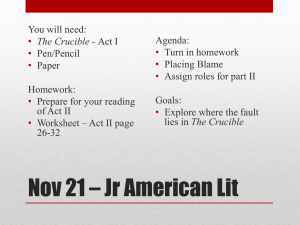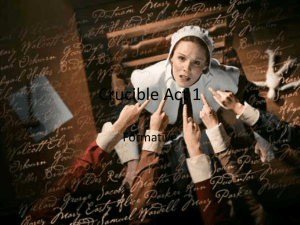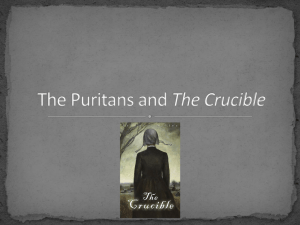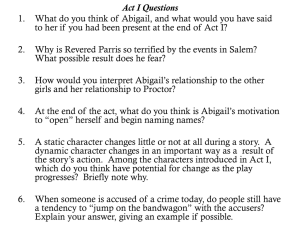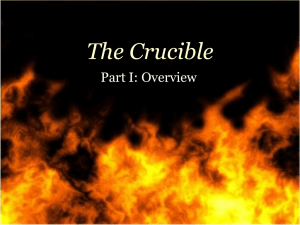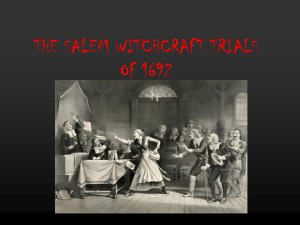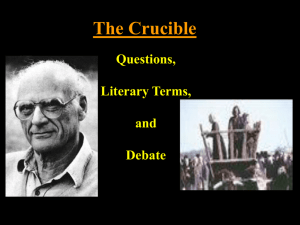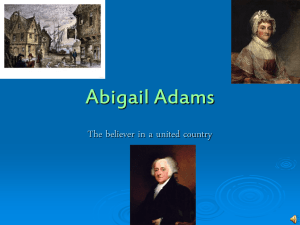The Crucible
advertisement
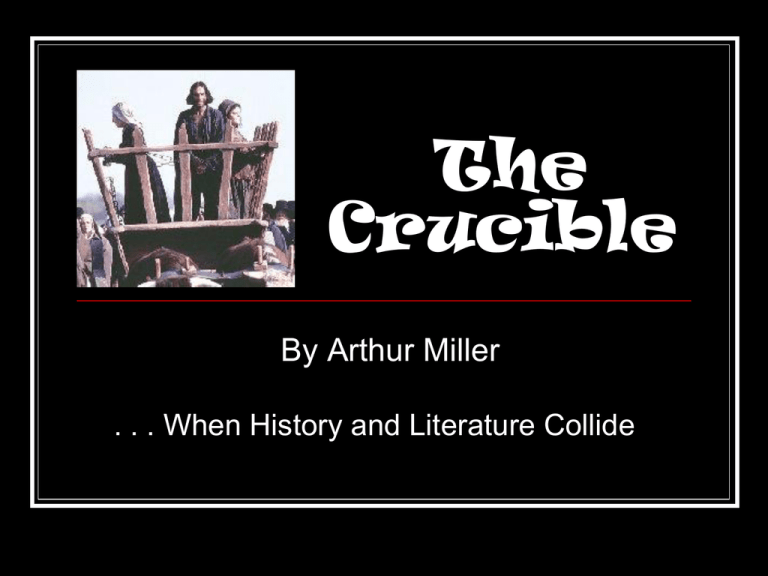
The Crucible By Arthur Miller . . . When History and Literature Collide The Crucible is . . . Puritanism + Witchcraft + McCarthyism + Arthur Miller Puritanism Christian faith that originated in England during the early 1600s Puritans believed in predestination They split from the Church of England in 1633 Many emigrated to the American colonies Their radical beliefs flourished in the new world Witchcraft in Salem Like all Puritans, the residents of Salem Village believed in witches and in witchcraft. They believed that witchcraft was “entering into a compact with the devil in exchange for certain powers to do evil.” They considered witchcraft both a sin and a crime; it was a very serious accusation, which was carefully and thoroughly investigated. Witchcraft in Salem The witchcraft hysteria began in Salem, Massachusetts, in early 1692. Reverend Samuel Parris’s daughter and Abigail Williams started having fits of convulsion, screaming, and hallucination. A doctor examined the girls and concluded that the only explanation for these bizarre behaviors was witchcraft. Witchcraft in Salem A recently published book of the time detailed the symptoms of witchcraft; the girls’ fits were much like those described in the book. Therefore, the Puritans of Salem were quick to believe the doctor’s diagnosis. Witchcraft in Salem The girls pointed fingers at Tituba (the Parris’ slave), Sarah Good, and Sarah Osborn, which sparked a witch hunt. Witchcraft in Salem During the next eight months of terror, more than 150 people were imprisoned for witchcraft. By the time court was dismissed, 27 people had been convicted, 19 hanged, and 1 pressed to death. The hysteria that snowballed in Salem reveals how deep the belief in the supernatural ran in colonial America. Arthur Miller 1915-2005 American Playwright and Writer In 1953 he wrote The Crucible, which uses the Salem witchcraft trials of 1692 to attack the anti-communist “witch hunts” of the 1950s. He believed the hysteria surrounding the witch craft trials in Puritan New England paralleled the climate of McCarthyism – Senator Joseph McCarthy’s obsessive quest to uncover communist party infiltration of American institutions. After the publication of the The Crucible, Miller himself was investigated for possible associations with the communist party. He refused to give information regarding his colleagues and was found guilty of contempt of court. His sentence was later overturned. Historical Background: About the Playwright Arthur Miller (1915-2005) was a lifelong defender of artists, whom he believed to have a social role to be politically critical and to challenge public ideas. He is famous for being the husband of Marilyn Munroe and being a prolific writer, whose best known plays, Death of a Salesman (1949) and The Crucible (1953) have been made into feature films and are still performed all over the world. Throughout his life he was persecuted for his views. The American context in which Miller wrote is the crucial basis for our understanding of this play’s universal message about the fragility of society. Historical Background: 1950s America and the Cold War After WW11 ended in 1945 with nuclear bombs a terrible reality, an arms race began between the Soviet Union (under Stalin) and the United States. Instead of a ‘hot war’ (with soldiers and weapons on the ground), the ‘cold war’ scenario played out with espionage, weapons research and aggressive diplomatic rhetoric. President F.D Roosevelt proposed the ‘New Deal’ economic programs which were considered ‘communistic’ by some conservatives. The FBI, under J. Edgar Hoover, worked for their vision of a rightwing society through arousing anxieties about a foreign menace, targeting dissidents and former members of the Communist Party of America, deliberately eroding the traditional liberal tolerance of diverse views. McCarthyism McCarthyism is the term used to describe a period of intense suspicion in the United States during the early 1950s. It began when Senator Joseph McCarthy, a U.S. senator from Wisconsin, claimed that communists had infiltrated the Department of State. A special House Committee on Un-American Activities was formed to investigate allegations of communism. During this period, people from all walks of life became the subjects of aggressive “witch hunts” often based on inconclusive, questionable evidence. McCarthyism Persons accused of being communists were often denied employment in both the public and private sector. In the film industry alone, over 300 actors, writers, and directors were denied work in the U.S. American writer, Arthur Miller, was one of those alleged to have been “blacklisted.” McCarthyism McCarthy’s influence finally faltered in 1954 when a famous CBS newsman, Edward R. Murrow, aired an investigative news report which revealed McCarthy as dishonest in his speeches and abusive in his interrogation of witnesses. The public was finally made aware of how McCarthy was ruining the reputations of many individuals through false accusations of communism. Edward R. Murrow Abigail Williams Orphaned niece of Reverend Parris She was once the mistress of John Proctor but was turned out when his wife discovered the affair. She is extremely jealous of Elizabeth Proctor and uses her power in the town to rid herself of Elizabeth as well as any others who have insulted her in the past. The original “Fatal Attraction”. She cannot let go of her obsession with Proctor. She is the leader of the girls. John Proctor Husband to Elizabeth He had an affair with Abigail when she was employed in his household. He knows that the girls are pretending but cannot tell what he knows without revealing having been alone with Abigail. When Abigail uses her influence to convict his wife, he tries to tell the truth and finds himself condemned. He refuses to admit to witchcraft or to consider Abigail as anything more than a liar. Elizabeth Proctor Wife of John Proctor She discovered an affair going on between her husband and Abigail Williams and turned Abigail out of her house. She is Abigail's main target but is saved from hanging because of her pregnancy. She feels responsible for driving her husband to infidelity. Tituba Servant to the Parris household She is a native of Barbados. She is enlisted by Ruth Putnam and Abigail to cast spells and create charms. When Abigail turns on her to save herself from punishment, Tituba confesses to all and saves herself. Reverend Parris Pastor of the church in Salem He is the father of Betty and the uncle of Abigail Williams. He believes that he is being persecuted and that the townspeople do not respect his position as a man of God. Deputy Governor Danforth He seems to feel particularly strongly that the girls are honest. He is sensitive to the presence of the devil and reacts explosively to whatever evidence is presented. The Girls Betty Parris- Daughter of the Reverend, cousin to Abigail Williams. She is a weak girl who goes along with her cousin as soon as she is threatened. Susanna Walcott-One of the girls. She is initially sent between Parris and Dr. Griggs to determine the cause of Betty's ailment. She is easily guided by Abigail. Mercy Lewis- Servant to the Putnam household. She is a merciless girl who seems to delight in the girls' activities. Mary Warren-Servant to the Proctor household. Abigail uses her to effectively accuse Elizabeth. John Proctor takes Mary to the court to confess that the girls are only pretending. She is not strong enough to fight Abigail and as soon as Abigail leads the other girls against her, Mary caves and runs back to her side by accusing Proctor himself. Drama Basics Drama Basics (cont’d) Internal Conflict: John Proctor As one of the central characters, John Proctor represents ideas about conflict in the mind. He is initially conflicted by the guilt he feels for committing adultery with Abigail. His actions with her go against his religion, his own morals and blemish the love he has for his wife. He is later conflicted by his decision to absolve himself through the Puritan system to publicly confess and perform an act of penance, or instead keep his personal pride by not allowing any public confession of his guilt. Conflict of Ideals: Reason vs. Hysteria One of the major conflicts in the play is between the reason of the human mind and the irrational fear of hysteria. Several characters try to use reason throughout the trials, yet Miller uses the reasoning of the courts to show the madness of those blinded by process. This absurdity is shown through Deputy Governor Danforth’s summary of the witch trials. He explains that because witchcraft is an invisible crime, only the witch and her victim can possibly witness the crime, and the witch would never accuse herself. Therefore, the victim’s testimony must always be accurate. As a result of this absurd reasoning, the Puritans had no way of objectively finding out the truth. Conflict between the individual and the state Salem’s ruling theocracy forces citizens to deny their consciences and perjure themselves in order to save their own lives. The majority comply, but a few heroic figures resist. Conflict within the community The accusations of witchcraft provide a smokescreen behind which simmering factional interests are exploited. Citizens use the accusations of witchcraft to gain vengeance, property or status. Conflict between husband and wife The tensions between John Proctor and his wife Elizabeth are ultimately resolved in the face of the larger threat that confronts them. Both must make difficult decisions about loyalty and morality. American Drama Drama is probably the most difficult form of writing. A play is not finished in the same way that a poem or novel is because after it is written, it still needs to be brought to life on a stage. A play primarily engages the enthusiasm of directors, actors, and technicians through the story. The playwright makes the audience concerned for a character by focusing on a conflict that involves something important to the characters. The protagonist of a play is the major character who usually drives the action forward. Exposition gives the audience background information. Most of the plays that are produced in the United States today are produced with the hope that they will make money. American Drama (cont’d) Playwrights must usually find an agent who submits a play to producers who are likely to consider it. The producer . . . . advances money to finance a play. meets with agents who represent the playwrights. works with a playwright on changes to a play. Theater is a collaborative medium. A director and actors “take away” a play from its author. Rehearsals are both pleasant and tense. Producers seldom take risks on plays. Thousands of plays are copyrighted each year. The audience can contribute to a good performance. This powerpoint was kindly donated to www.worldofteaching.com http://www.worldofteaching.com is home to over a thousand powerpoints submitted by teachers. This is a completely free site and requires no registration. Please visit and I hope it will help in your teaching.

